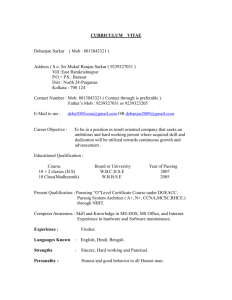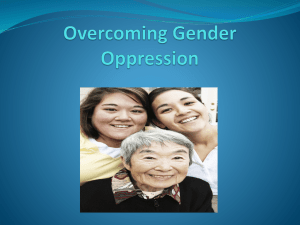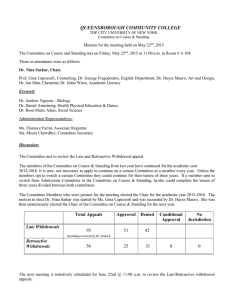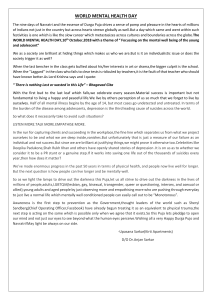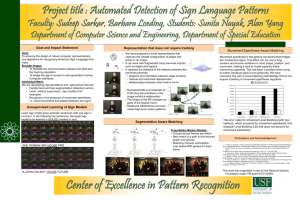Neohumanist Education: The Sarkar Game & Futures Thinking
advertisement
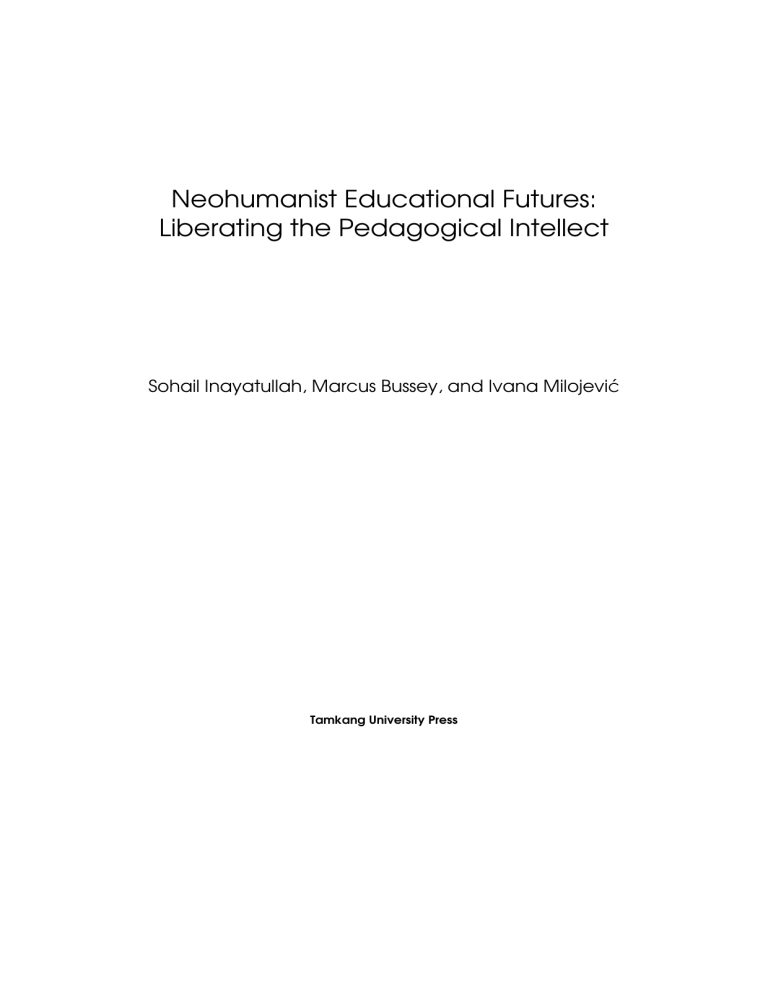
Neohumanist Educational Futures: Liberating the Pedagogical Intellect Sohail Inayatullah, Marcus Bussey, and Ivana Milojević Tamkang University Press First published 2006 by Tamkang University in association with Gurukula Press and Metafuture.org. Graduate Institute of Futures Studies, Tamsui, Taipei, Taiwan 251. future@mail.tku.edu.tw, www2.tku.edu.tw/~tddx Gurukula Press, P. O. Box 879, Maleny, Qld., 4552, Australia. gkpress@gurukul.edu Metafuture.org, info@metafuture.org, www.metafuture.org. Copyright © 2006. This work is copyright. Copyright in the work as a whole remains with Tamkang University, the editors—Sohail Inayatullah, Marcus Bussey and Ivana Milojević — and contributing authors. All rights reserved. No part of this book may be reproduced or transmitted in any form or by any means, electronic or mechanical, including photocopying, recording or by any information storage and retrieval system, without prior permission in writing from the publisher or the editors. 1. Inayatullah, Sohail, 1958 –. II. Marcus Bussey. III. Ivana Milojević. ISBN: 986-7385-63-2 Cover illustration: Detail Kundalini, 2004, by Marjorie Bussey (mbussey@ozemail.com.au) Additional copies may be obtained from: info@metafuture.org, gkpress@gurukul.edu and future@mail.tku.edu.tw Chapter 14 Playing the Neohumanist Game Peter Hayward and Joseph Voros In the Master of Science in Strategic Foresight offered at Swinburne University in Australia the first year of a student’s study is concluded with the subject ‘Dimensions of Global Change’. After studying the history, the methods and the use of futures methods, students are then exposed to the idea of the ‘constructedness’ of theories of social change. An outcome of this subject is for students to become aware of the deep macrohistorical processes that shape and contour both ‘presents’ and ‘futures’. P. R. Sarkar’s ‘Social Cycle’ elegantly demonstrates how easily ‘social roles’ are adopted and how these roles bring forth partial and limited understandings of change and change processes. As a macrohistorical model of social change and as an embodiment the process of social construction, it is a pivotal learning element in the subject. Ken Wilber suggests that developing an ‘integral’ or ‘meta’‐perspective allows the individual to honour all participants’ perspectives and can generate interventions and behaviours that can act with greater effectiveness and sustainability on a social system.1 Here, too, Sarkar is relevant, as the role of the Sadvipra in the social cycle is both theory and action that embodies ‘integrality’. By ‘creating’ the experience of the social cycle in the classroom, via the playing of the ‘Sarkar Game’, students learn of their own social constructions and roles. They experience the frustration of how these roles and constructions limit the effectiveness of their actions. They can also recognise the qualitative difference in the potential of actions that arise from adopting an ‘integral’ stance in participating in social change. In this way it is argued that the playing of the game is more than an alternative to the traditional pedagogy of education. The game also acts as a developmental pacer to the establishment of neohumanistic perspectives. After briefly examining Sarkar’s idea of neohumanism this chapter will explain the mechanics of how the Sarkar Game is staged and it shall then draw upon observations of participant learning in order to demonstrate the claim about developing neohumanist perspectives. Participants have 283 included students at Swinburne University, senior Australian executives at Melbourne Business School (Mt Eliza Centre for Executive Education) and Ananda Marga meditation teachers and practitioners. Sarkar’s neohumanism Sarkar held an image of a positive future for humanity notwithstanding that he also saw that history tended to repeat itself in repetitive cycles. One element in Sarkar’s positive image of the future was the need to ground the rationality of scientific modernity in a universal humanism—what Sarkar called ‘neohumanism’. Sarkar’s project is not to leave the rationality of scientific modernity for the irrationality of the religious, rather, it is the creation of a new rationality that attempts to reconcile traditional dilemmas between spiritual and material, scientific and mystical, individual and collective, structure and agency. His rationality is centered not only on humans though, an integral part of the rational is pure, undefined and unbounded Consciousness.2 What Sarkar rejected was a rationality that both depended upon, and created, the dialectical ‘other’; to him this was truly ‘irrational’. “For Sarkar, the rational must be an identity that is all embracing, the ultimate real. Being itself”.3 This new rationality progressed “from the crude mind (located in the senses) to the ego mind (located in the intellect) and the transpersonal causal mind (located outside of brain in the collective mind”. 4 His agent of development was the individual first, but this individual increasingly became aware of the social realm and so consciousness became socially‐aware rather than individually‐focussed. Sarkar took the ontological position of Tantra—to liberate oneself from crudeness—and this struggle was both individual and social and not a merely passive spirituality.5 The social expression of the mystical cosmology of Tantra is Neohumanism. Sarkar’s theory of Neohumanism aims to relocate the self from ego (and the pursuit of individual maximisation), from family (and the pride of genealogy), from geo‐sentiments (attachment to land and nation), from socio‐sentiments (attachments to class, race and community), from humanism (the human being as the center of the universe) to Neohumanism (love and devotion for all, inanimate and animate, beings of the universe). As the intellect is liberated from these bondages of ego and other identities, there arises (1) higher and higher degrees of 284 empathy and compassion; (2) increased commitment to social equality instead of ego‐pleasure; (3) increased levels of unity with the Other, and (4) a re‐identification of the self with the Cosmos.6 Wilber makes a similar point in his schema of human development through the self‐stages, from (1) biocentric; (2) egocentric; (3) sociocentric; to (4) world‐centric. 7 He decribes the developmental drive as a battle between evolution and egocentricism—between greater depth and complexity versus stability and control. It is not argued that the playing of the Sarkar Game achieves the full extent of liberation that Sarkar’s neohumanism delivers or but it is argued that the learnings from the game can act as transformational events that could serve to commence the liberation of intellect and the continuing evolution of human consciousness. Sarkar’s social cycle Sarkar’s theory of the social cycle is concerned with the ways that humans, and their social organisations, have dealt with the existential problems of how their physical and social environments relate to one another. His theory of macrohistory8 proposes that civilisation has cycled through four major ‘states’: being dominated by the environment; attempting to dominate the environment with the body; attempting to dominate the environment through the mind; and, by dominating it through the agency of the environment itself. His theory defines these four ‘states’ as both material power structures and as epistemic or paradigmatic forms of individual and collective psychology. Further, each state has a beneficial phase (vidya) and a perverse phase (avidya); thus, even though each state is successful in managing existential problems, it also contains the seeds of its ultimate decline. Furthermore, according to Sarkar, the development of a group of people, or their social organisation, requires six factors to be present: spiritual ideology of self and consciousness; a process by which the ideology can be realised; a theory of value and its distribution; a fraternal social outlook which would govern position and place of individuals; scripture or an authoritative text for inspiration of self and society; and a Founder or someone who can ‘lead the way’. 285 The efficacy of each of the stages of Sarkar’s social cycle could be determined by the extent to which these six factors were satisfied. Each stage would have its own distinct slant on how the group would be developed and what mechanisms might be employed. In its vidya phase a stage will meet these six factors in a beneficial form, while in the avidya phase it will become perverse. His first state is that of the Worker or Shudra. The Worker is controlled by the environment, never dominant over it. The source of power for the Worker is chaotic power, and it is also the Worker who is the agent of the other stages of the cycle. The Worker lives in the present. The benign form of the Worker stage is service to the other stages, the malignant form is revolt or disruption of service. The six developmental factors for the Worker are met through giving service to the other stages and, in turn, how the forms of organisation of those stages address the developmental factors. To the extent that a stage meets developmental needs (vidya), the Worker continues to give service. Once the stage turns perverse (avidya), Workers revert to chaos or disruption until the next vidya stage arises. The first organised stage is called the Warrior stage or Ksattriya. This stage struggles with and dominates the environment through its power of polity or civil order. The Warrior is materialistic and is concerned with conquering the material world. Like the Worker, the Warrior lives in the present, but also in the past (for example, stories of ‘glory’ days, victories, etc.). From an historic perspective this is the era of physical strength, heroes, chieftains, clans and empires. Power was created by conquest of others and appropriation of their wealth. In its vidya phase the Warrior stage would satisfy the six developmental factors by protecting the rights of Workers through an external focus on the mechanisms of civil order which would provide protection and provide for their material needs. It would define a place or role in the group and define a greater good for the Worker to serve. This order would be headed by a general, chief or king, and in history was seen as the establishment of empires and ancient nations. In its avidya phase the mechanisms of civil order would be employed to oppress the Workers and exploit them. The Warriors would fail to provide protection and would give the Workers nothing to serve. Material satisfaction would fail to satisfy the Workers. The world would become overly centralised and culturally stagnant. The existence of the Warrior avidya phase creates the conditions for the emergence of the next stage. This next organisational stage is called the Intellectual stage or Vipra. 286 The intellectuals gradually wrested the right of controlling society from the hands of the warriors, and with the help of warrior power they established their own sway and dominance over society. They [convinced] the warriors that worshipping the intellectuals was the chief virtue and characteristic of the powerful warriors.9 The Vipra stage struggles with and dominates ideas through its control of the intellectual space. However it is also worth noting that the Vipra stage employs the means and structures of the previous stage to ensure its own success. The Intellectual view is ideational (non‐materialistic). As the power for this stage comes from ideational/normative means, it should not be surprising that most recorded history is Vipra history, for most history is written and told by Intellectuals.10 Whereas the Ksattriya stage gave us the hero and his successful wars and conquests, in the Vipra phase the battle is fought by the undoing of the intellectual constructions of others and the creation and promotion of one’s own. The Intellectual lives in past, present and future, where future is concerned with metaphysical idealism, not modernity.11 In its vidya phase the Intellectual stage would satisfy the six developmental factors by use of ideational creativity to create an ideology; the value of this ideology would be truth and meaning. The process to achieve the ideology’s outcome would be to ensure learning and to teach others in order for them to discover truth. The fraternal outlook would come from the culture of those who share the beliefs, the recorded intellectual construction would be the texts, and the priest or intellectual would fulfil the founder role. Political participation would be the vidya phase of the Vipra social stage, as would organised religion. In its avidya phase the Intellectuals would use their normative power to create a universe where knowledge in only available to the select few. 12 The ideologies would be used to exploit the Workers and to marginalise the ‘others’ (women, slaves, etc.) in the system. The material world of the Workers and marginal groups are neglected and so the conditions for the next stage are created. The bondage of the material world keeps them so viciously in its octopus‐like grip, that in spite of their intelligence, they do not have the courage to [challenge the acquisitors]. The Intellectual age dies but not the intellectuals themselves. The blood‐sucking acquisitors get volumes of philosophical books written and truth 287 tactfully and artfully perverted and distorted with the help of the paid intellectuals.13 Thus the social stage moves to that of the acquisitors or Merchants, the Vaeshya. Once again the new stage absorbs the means and methods of the previous stage to ensure its success. The needs of the material world have moved the focus from the ideational to the materialistic once again. The power for this stage comes from the market in the form of the entrepreneurial spirit. In its vidya phase the Merchant stage would satisfy the six developmental factors by use of entrepreneurship to establish an ideology of material production; the process is the application of wealth to assist the material condition of the Workers through the civil processes established by the Warriors. The value of this stage is wealth or commodification; the fraternal social outlook is that the material wealth is shared all those who create and participate in the market process. The texts would be drawn from the writings of the Intellectuals, and leader capitalists would come from the market itself. When the avidya phase of the Merchants arises, the material wealth is accumulated by the Merchants rather than distributed—the Workers become the slaves of the Merchants and exploited through “seducing the poor and weak into believing that they all benefit from the system”.14 The ideational activities of the Intellectuals are commodified and brought into the material world, and the role of civil order to provide protection of rights instead becomes just another service, which has to be acquired rather than expected. “[T]he acquisitors are the murderous parasites of the social tree who want to kill the main tree by sucking out all its sap”.15 Thus the conditions are ripe for the return of chaos through a Worker’s revolution or revolt and the cycle is completed with the time now set for the next (and higher) version of the Ksattriya stage to occur and the cycle to repeat. It is also possible that the cycle could regress to an earlier Vipra‐ led ideational revolution. The following table summarises the stages of Sarkar’s social cycle and shows how each of the organised forms achieves its objective—worker service—to ensure that its own focus of domination is brought about and its power source to do so. It also shows each stage in its vidya (beneficial) and avidya (perverse) forms. As each stage succeeds the earlier one it assumes the means and methods to its own aims. 288 Table 1: The stages of Sarkar’s social cycle WORKER—SERVICE/CHAOTIC POWER—Shudra WARRIOR STAGE— Ksattriya INTELLECTUAL STAGE—Vipra CAPITALIST STAGE— Vaeshya Focus on Materialistic (Environment) Ideational (Ideas) Materialistic (Ideas and Environment) Power from Polity (Order) Intellectual (Normative) Market (Entrepreneurship) Vidya Protection of worker rights Learn/Teach Truth and Meaning Application of material gain Oppression of worker rights Maintain/Enforce Truth and Meaning Accumulation of material gain Form Avidya Form The final point to make about Sarkar’s social cycle is that, in addition to those forces described above, he envisaged another force which operated for the benefit of the entire cycle, not simply one stage of it. That is, a force which produces the leadership type and the institutional forms necessary to enable the emergence of the vidya forms of each of the organising stages, but to also take the necessary steps to move the cycle forwards when the avidya forms becomes dominant. This force he called the Sadvipra—one with a complete and pure mind. The sadvipra form of leadership would have the characteristics of all the vidya forms of the stages, Worker (service), Warrior (protection), Intellectual (theory generation) and Merchant (entrepreneurial spirit), but it would not be a rival power to any of the organised stages, nor would it favour any one stage over another. For Sarkar, given that these forms of power evolve historically, they are for all practical purposes natural; they cannot be eliminated or collectively transcended. The task for Sarkar is to transform this historical social cycle—labourer, warrior, intellectual, capitalist, labourer—into a social spiral thus allowing power to enable progressive forms of economy, culture and polity.16 The Sadvipra is the embodiment of an integral perspective and action and the means by which the traditional social forces can be transcended and society can evolve rather than merely change. The Sadvipra ‘transcends’ the vidya/avidya dynamic of the social cycle and, indeed, the social cycle itself. The vidya phase arises from introversion and the avidya from extroversion. The directional force of the social cycle arises from the 289 relativity of introversion or extroversion that is present at a given transition. Introversion leads to increased clarity, to compassionate action that emerges from the desire for social equity. Extroversion leads to sin or the misuse of spiritual, mental or physical resources. Introversion calms the perturbations of the mind, leading to right thought and action.17 An excess of introversion leads to evolution or revolution; an excess of extroversion leads to downfall. A balance is stasis. His Sadvipra leader contains or embodies the vidya forms of each of the stages (service, protection, intellectual and innovation) so that, when an excess of extroversion begins to occur in one stage, the Sadvipra enters to return that stage to stasis. Then the Sadvipra leader creates an excess of introversion from which the evolution/revolution to the next stage will occur. The Sadvipra is not an inactive witness. He is an active participant to see that no person or class exploits the rest. For this he may even have to resort to physical violence because the Sadvipra will have to strike at the source of power which is tending to become the exploiter. In case the Ksattriya class is becoming exploitive, the Sadvipra may have to resort to physical force and in an age where the intellectual or Vipra class is dominating, he will have to bring a revolution in the intellectual field. In case the Vaeshyas are dominating, the Sadvipra may have to contest and win elections because the Vaeshya class rule by democracy and the democratic set‐up enables them to accumulate undue gains.18 Sarkar’s theory underpinned the design of the experiential learning process. The participants would adopt Sarkar’s social roles and experience change managed without a Sadvipra or integral perspective, and without any understanding about the social cycle (i.e. no prior knowledge). The Sarkar Game The class members wereplaced in equal groups in the four corners of the room or space. Each group was given a ‘script’ for their group. Each script was simply a list of three to four sentences that captured the essence of the four ‘social cycle’ groups (Worker, Warrior, Intellectual, Merchant) without using the name. The teachers stood in the middle of the room. 290 First the Worker group was asked to begin the game by making their claims of the system (Food, Shelter, Safety!) and then Warriors were invited to respond to the Workers. The interchange between those two groups was allowed to continue until the form became avidyan, at which point a teacher held up a red card (as a referee does in many international sports!) and stopped the process. The Intellectual group were invited in and asked to respond to each of the other two groups. That interchange was allowed to continue until it too turned avidyan (red card!). Then the Merchant group was invited in and the process was repeated. The first observation from the teachers was that the process was fun and lots of energy went into the game. The groups very quickly dropped into the caste roles, even with their very simple scripts. To close the learning loop the experience was followed with a lecture—that drew out Sarkar’s theory from the experience and insight of each of the groups. The lecture is very proactive with participants invited to suggest, ‘how the cycle works’, and the observation made that the key role of the sadvipra was made very clear by the example of the teachers during the game. The lectures can go on for over two hours and have had to be ended because of time pressure, rather than any lack of participant interest. Individual transformations through the Game The Sarkar game experience taps into the ‘deep’ scripts that we all have; scripts that cover role, power and relationship. Our societal processes have programmed those scripts into us and they continue to operate unconsciously until an experience draws them into consciousness thereby making them accessible to inquiry and examination. Participants experience the Shudra‐ego as one of power and powerlessness. They learn that they are the energy of the system—they begin and end the game and yet they do not have a collective consciousness. Interestingly most Shudra groups tend to coordinate even though their instructions clearly state that they are individuals and not a collective. Such coordination tends to reduce the overall energy of the game and tends towards a passive Shudra. For some participants the opportunity to adopt extreme individualism is clearly liberating. Some Shudra participants have quickly cut private deals, stolen weapons from the Ksattriya and also taken the money of the Vaeshya. Shudra energy is high ego and as such is both the base of neohumanism and also the first stage of transcendence. The observation here is that without the liberation of the untrammelled 291 ego subsequent liberation is diminished. With the full rush of ego comes sufficient energy to give the potential of further development. Ksattriya‐ego is strongly inwardly focussed notwithstanding their power to dominate the environment. For many participants the experience holding the only weapons in the game is both visceral and powerful. It is also a strongly collective episteme with members very protective of one another. Some Ksattriya groups have deliberately hidden or refused to take up their weapons and this has the impact of denying the game its initial dramatic tension. It would seem that the game cannot start until the Ksattriya ‘announce’ their power to the system. The conclusion here is that the unwillingness to take up the weapons is tantamount to refusing the warrior code and strangely enough does not serve the game well. This point is made clearer in the debrief/lecture when the Ksattriya realise that the weapon is both power with responsibility and that they cannot effectively protect until they show that they accept power and that they also accept their responsibilities. In later iterations of the game the displaying of weapons has been made a mandatory element of playing that role. In terms of neohumanistic development the Ksattriya role can reach the stage of socio‐sentiment, principally around race or class but cannot transcend this stage alone. A recurrent issue with this role is the taking up of arms to protect. Sarkar himself preferred non‐violence but clearly foresaw the need for violent revolution in certain circumstances.19 There is a clarity and simplicity to Ksattriya that exposes the prevarication and obfuscation that is often cited in defence of protective inaction. One either protects or one does not. The good is not measured by intention but by action and within this stance is the clear impetus to transcend the pursuit of individual maximisation. Often groups taking the Ksattriya role comment on its sacrificial nature where individual nature is subsumed into social duty. Thus Ksattriya is the stage that begins to temper the excesses of Shudra‐ego and the crude mind. For many participants Ksattriya is a hugely revealing social role to play. They enjoy the power that comes from being able to dominate the environment but they also become aware of the equal responsibility that comes with that power. The Vipra role is a devastating one for many participants. Most have no idea how to operate within this episteme. It is obvious from many iterations of the game that most participants are incompetent in this role. With their felt incompetence comes impotence and Vipra generally has little, or no, influence in the game. Some participants comment that they have ‘nothing, only ideas’ whereas others have instrumental power and 292 yet participants also realise that it is ideas, more so than instrumental power, that has changed the world. Vipra also tends to try and speak directly to Shudra‐ego and by doing so Ksattriya is ignored. Often the weapons of the warriors are turned towards these ‘Vipra‐troublemakers’. One Warrior tellingly reported in the lecture that, “I originally thought that the Shudra were the problem but then I listened to the Vipra and I realised that they wanted to change things. They were the real problem”. Many participants recall that this is how it often feels when new ideas are brought to an organisation. Sarkar says that only Vipra can conquer the fear that Ksattriya have of their death by writing their history and thereby making their honour live forever. Most Vipra do not understand how they can work with Ksattriya rather than just be seen as a threat. Effective Vipra do not try to dominate the physical environment but attempt to adopt authoritative stances on the periphery. Almost no‐one has played Vipra as a ‘large’ force—they are almost always small and come across as apologising for their ‘inconvenience’. The observation here is that neohumanist development is stunted without the spiritual leadership of the Vipra. Without the Vipra ideology is non‐existent and the game is imbalanced. There is a vacuum in the game and into that vacuum step the Vaeshya. Almost always Vaeysha divide and conquer the game. They almost never operate as a collective group, instead they usually split up and try and cut deals; Ksattriya first and Shudra second. They often ignore the Vipra completely. The observation here is that Vaeysha have the simple ideology of personal gain. In the typically Vipra‐less game dynamic, this ideology is quickly adopted as the default ideology for all groups. If Ksattriya demonstrate the potential to take neohumanistic development to the point of transcending socio‐centric bonds then the Vaeysha almost always pull development back to the level of the crude mind again. If Vaeysha overplay their hand then they can disgust the Ksattriya for their lack of honour or they can cause Shudra to feel ‘used’. Generally, however, there is usually a favourable response to Vaeysha, largely because the Vipra are usually ineffectual. In only two games have the Vaeshya failed to have impact—no one in the two games could impose Vaeshya ideology upon the game and this had the effect of removing that dynamism from the game. An observation here is that in some groups—those with social reform agendas—an inability to play this role would hinder rather than aid their overall social change agenda. Another observation is that the understanding of the power of the Vaeshya is rarely matched with an equal understanding of their responsibility, other than the responsibility to 293 the crude mind. The traditional ideology of the Vaeshya is just too limited to take the whole cycle very far forward. Finally is the Sadvipra role. Most participants agree that Sadvipra is not another distinct role in the game but is a meta‐perspectival stance from which any of the other stages of the game can be played. Most agree that the major challenge in taking such a stance is the adequacy of the personal ideology of the actor. The Sadvipra role would seem strongly neohumanist in ideology but, of course, no game alone is going to evoke neohumanist rationality. The Sarkar Game makes no claims in this respect other than to suggest that participants do observe the tendency of the social cycle to perpetuate suffering, rather than alleviating it, without the injection of a different level of consciousness. If the participant experience of the game is that ‘something else’ is needed and that individuals might then begin the search for the missing ‘thing’, then perhaps the game has lived up to Sarkar’s intent. Social transformation through the Game Sarkar made the point that while the agent of transformation is the individual it is the creation of social consciousness outside the individual that enables true social justice and progress. Once individuals have played the game and they have observed the deep social structures, they can return to the game with a changed perspective. Now they are no longer actors in a drama; instead they can adopt the neohumanist perspective of the Sadvipra. The ‘game space’ now becomes a diagnostic space where alternative strategies can be trialled, dialectic positions can be examined and the crude mind of individual gain can be transcended. The observation here is that participants with this new perspectival knowledge can readily adopt neohumanist stances. The ego‐mind and “I”‐sense is replaced with the collective‐mind and “We”‐sense, or indeed, a synthesis of both. In this phase senior corporate executives have been asked to describe the genealogy of their organisations by reference to the game. What stage of the cycle are they at? Is the system vidyan or avidyan? What episteme is dominant and which are repressed or ineffectual? What does the Sadvipra perspective bring to the executive? All executives were easily able to see their organisations from a collective neohumanist perspective. When they saw themselves as ‘mere’ actors in a drama, they saw the futility of their actions. The neohumanist perspective, however, brought forward new strategies that honoured the role that all could offer the social cycle and, 294 importantly, emphasised the understanding of the ideologies that drive the organisation. Most executives saw the Ksattriya and Vaeysha epistemes as dominant in their organisations, the Vipra role as being ineffectual and the Shudra either powerless or exploited by the system. The neohumanist perspective of the collective‐mind challenged the ideological basis of the leader and naturally followed on to an examination of the sadvipra role again. The ideational, spiritual foundation that is shared by both Vipra and Sadvipra is a tremendous challenge to most game participants. The observation here is that the pragmatic ideology of organisational realities honours only the externally focussed epistemes and denies the ideational. Participants become aware of this and yet they are personally challenged by the idea that they need to become spiritual beings in order to become Sadvipra leaders. As a contrast, when the game was played amongst Ananda Marga monks then the opposite realisation was made by the movement’s leaders. The observation here was that as individuals they were poor at the Vaeysha episteme and this compromised the collective mind capacity of the movement. Their challenge was the opposite of that faced by the business executives—how could they become Merchant‐beings in order to become the Sadvipra leaders that their circumstances required? It should also be noted that even people well schooled in the theory of Sarkar gained deep learning from this simple game. While observing the game with the Ananda Marga monks Dada Shambhushivananda, Vice‐Chancellor of Gurukul University, noted how useful it was for Ananda Marga meditation teachers and practitioners, as it deepened participant’s understanding of Sarkar’s theory of social change. Inayatullah, a student of Sarkar for over 30 years, also commented that he “learned as much in 20 minutes of the Sarkar game as he had learned in 30 years of textual analysis”. The general observation drawn from these two games was that Sadvipra social change can only eventuate when all stage epistemes are available in their vidya forms. Conclusion The participant experience of the traditional roles of managing and driving social change clearly demonstrates the one‐sidedness of contemporary Western culture. The game dynamics clearly showed how our programmed selves are comfortable with external forms of managing social change (Ksattriya or Vaeysha). In this ‘world’, guns or butter make you a player. Yet Sarkar clearly demonstrates that this is only half of what is available for managing social change. The ideational realm is equally 295 powerful in creating and managing change, yet the observation of the game is that many appear to have forgotten how to do this. Most importantly, the game allows the demonstration of action informed from an integral perspective. The sadvipra is not merely a theoretician or an idea, but an active agent in social change. The sadvipra acknowledges the necessity and insufficiency of each of the traditional social roles. Each is an integral element (vidya) but each must be transcended to ensure the integral cycle continues. Without adequacy in all game epistemes then neohumanist change may be unlikely. The game, therefore, is a serious one. While we ‘play’ at learning, the consequences of not learning are serious indeed. Sarkar’s social cycle at its heart is revolutionary, and thus a sadvipra is a social revolutionary operating from a neohumanistic ideology. Readings 1 K. Wilber, A Brief History of Everything, Shambhala, Boston, 1999. 2 S. Inayatullah, Understanding Sarkar: The Indian episteme, macrohistory and transformative knowledge, Brill, Leiden, 2002, 2. 3 Ibid, 3. 4 Ibid, 4. 5 Ibid, 8. 6 Ibid. 7 Wilber, op cit., 165. 8 J. Galtung & S. Inayatullah (eds.), Macrohistory and Macrohistorians: Perspectives on Individual, Social and Civilisational change, Praeger, London, 1997, 132‐140. 9 S. Inayatullah, Situating Sarkar: Tantra, macrohistory and alternative futures, Gurukula Press, Brisbane, Australia, 1999, 55. 10 Ibid, 8. 11 Ibid, 56. 12 Ibid, 3. 13 Ibid, 56. 14 Inayatullah, 2002, op cit., 123. 15 Inayatullah, 1999, op cit., 56. 16 Ibid, 63. 17 Inayatullah, 2002, op cit., 129. 18 Ibid, 165. 19 Ibid, 163. 296
